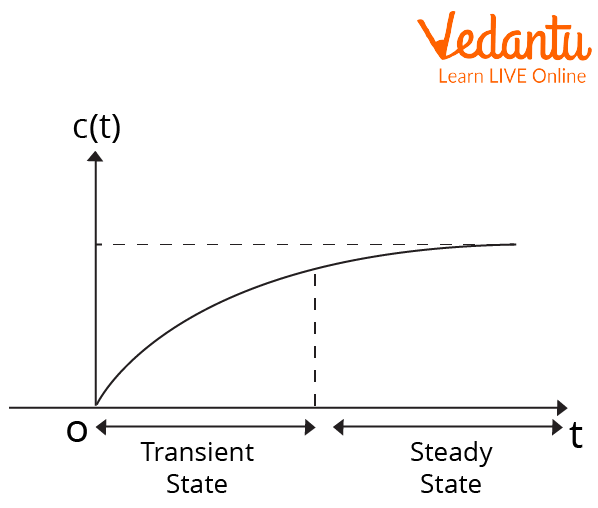




How to Apply the Final Value Theorem in Laplace Analysis
The Final Value Theorem is a fundamental tool in a circuit system working. It is based on Laplace functions and their transformation. So, to understand the final theorem, we need to have some idea about Laplace transformations. In this article, we will be discussing the final value theorem in depth. We will also discuss the application of the final value theorem in circuit systems and how problems related to the theorem can be solved will also be discussed in this article. Below is the figure which shows the state for a function:

Steady-state Function
History of Pierre-Simon Laplace

Pierre-Simon Laplace
Name: Pierre-Simon Laplace
Born: 23 March 1749
Died: 5 March 1827
Field: Mathematics
Nationality: French
Statement of the Final Value Theorem
The final value theorem states that if $x$ is any function of $t$ and Laplace transformation of $x$ is denoted as X(s), i.e., \[x(t) \underrightarrow{L T} X(s)\]
then,
$\mathop{\lim}\limits_{t \rightarrow \infty}x(t)=x(\infty)=\mathop{\lim}\limits_{s \rightarrow 0}sX(s)$
Here, LT represents Laplace Transformation.
Proof of the Final Value Theorem
From the definition of the unilateral Laplace transform, we have
$L[x(t)]=X(s)=\int_{0}^{\infty} x(t) e^{-s t} d t$
Taking differentiation with respect to time on both sides, we get $L\left[\dfrac{d x(t)}{d t}\right]=\int_{0}^{\infty} \dfrac{d x(t)}{d t} e^{-s t} d t$
Now, by the time differentiation property, i.e., $\dfrac{d x(t)}{d t} \underrightarrow{L T}\:s X(s)-x\left(0^{-}\right)$ of Laplace transform, we have
$L\left[\dfrac{d x(t)}{d t}\right]=\int_{0}^{\infty} \dfrac{d x(t)}{d t} e^{-s t} d t=s X(s)-x\left(0^{-}\right)$
By taking the $\mathop{\lim}\limits_{s \rightarrow 0}$ on both sides of the above expression, we get
$\mathop{\lim}\limits_{s\to0}[\int_{0}^{\infty}\dfrac{\text{d}x(t)}{\text{d}t}e^{-st}dt]=\mathop {\lim }\limits_{s \to0}[sX(s)-x(0^{-})]$
$\Rightarrow \int_{0}^{\infty} \dfrac{d x(t)}{d t} d t=\mathop{\lim}\limits _{s \rightarrow 0}\left[s X(s)-x\left(0^{-}\right)\right]$
$\Rightarrow[x(t)]_{0}^{\infty}=\mathop{\lim}\limits _{s \rightarrow 0}\left[s X(s)-x\left(0^{-}\right)\right]$
$\Rightarrow x(\infty)-x\left(0^{-}\right)=\mathop{\lim}\limits_{s \rightarrow 0}\left[s X(s)-x\left(0^{-}\right)\right]$
$\Rightarrow x(\infty)=\mathop{\lim}\limits_{s \rightarrow 0} s X(s)$
Therefore, we have
$\mathop{\lim}\limits_{t \rightarrow \infty} x(t)=x(\infty)=\mathop{\lim}\limits_{s \rightarrow 0} s X(s)$
Limitations of the Final Value Theorem
The Final Value theorem does not apply when the Laplace transform has imaginary but non-zero poles as the limit of time response does not exist.
The Final Value theorem does not apply when the pole is in the right half plane.
Applications of the Final Value Theorem
The Final Value theorem has wide application in electronic devices or circuits.
The Final Value theorem is used to find the steady or transient state of a function.
The Final Value theorem is used to find the transient state gain of a wash-out function.
Solved Examples
1. What is the steady state value of f(t), if it is known that $F(s)=\dfrac{2}{s(s+1)(s+2)(s+3)}$.
Ans: From the equation of $F(s)$, we can infer that a simple pole is at the origin and all other poles are having negative real parts.
$\therefore f(\infty)=\mathop{\lim}\limits_{s \rightarrow 0} s F(s) $
$\Rightarrow f(\infty)=\mathop{\lim}\limits_{s \rightarrow 0} \dfrac{2 s}{s(s+1)(s+2)(s+3)} $
$\Rightarrow f(\infty)=\dfrac{2}{(s+1)(s+2)(s+3)} $
$\Rightarrow f(\infty)=\dfrac{2}{6} $
$\Rightarrow f(\infty)=\dfrac{1}{3}$
2. What will be the inverse Laplace transform of \[F(s)=\dfrac{2}{s^{2}+3 s+2}\]?
Ans: $s^{2}+3 s+2=(s+2)(s+1)$
Now, $F(s)=\dfrac{A}{(s+2)}+\dfrac{B}{(s+1)}$
Hence, $A=\left.(s+2) F(s)\right|_{s=-2}$
$\Rightarrow A=\left.\dfrac{2}{s+1}\right|_{s=-2}$
$\Rightarrow A=-2$
And, $B=\left.(s+1) F(s)\right|_{s=-1}$
$\Rightarrow B=\left.\dfrac{2}{s+2}\right|_{s=-1}$
$\Rightarrow B=2\\$
$\therefore F(s)=\dfrac{-2}{(s+2)}+\dfrac{2}{(s+1)} $
$\therefore F(t)=L^{-1}\{F(s)\} $
$\Rightarrow F(t)=-2 e^{-2 t}+2 e^{-t} \text { for } t \geq 0$
3. What will be the inverse Laplace transform of $F(s)=\dfrac{2}{s+c} e^{-b s}$?
Ans: $\text { Let } G(s)=\dfrac{2}{s+c} $
$\text { Or, } G(t)=L^{-1}\{G(s)\} $
$\Rightarrow G(t)=2 e^{-c} $
$\therefore F(t)=L^{-1}\left\{G(s) e^{-b s}\right\} $
$\Rightarrow F(t)=2 e^{-k(t-b)} u(t-b)$
Important Formulas to Remember
If $x(t)\:\underrightarrow{L T}\:X(s)$,
Then $\mathop{\lim}\limits_{t \rightarrow \infty} x(t)=x(\infty)=\mathop{\lim}\limits_{s \rightarrow 0} s X(s)$
Laplace transformation: $L[f(t)]=F(s)=\int_{0}^{\infty} f(t) e^{-s t} d t$
Important Points to Remember
Laplace transformation is an essential tool to learn the final value theorem.
Circuit Diagrams and electric circuits are based on the application of the final value theorem.
Conclusion
The Final Value Theorem has a wide range of applications in daily life and it is a fundamental tool for functional analysis and electrical circuits. In the above article, we have discussed the Final Value theorem in brief, and the limitations of the theorem are also discussed. So, in short, we can say that the Final Value theorem forms a vital component of our life and makes our day-to-day work easy.
FAQs on Final Value Theorem of Laplace Transform Explained
1. What is the Final Value Theorem of Laplace Transform and what is its primary purpose?
The Final Value Theorem (FVT) is a principle in mathematics and engineering that relates the time-domain behaviour of a function as time approaches infinity to the frequency-domain behaviour of its Laplace transform as the frequency variable 's' approaches zero. Its primary purpose is to determine the steady-state value of a system's response, such as a voltage in a circuit or the error in a control system, directly from its Laplace transform F(s) without needing to calculate the full inverse Laplace transform.
2. What is the mathematical formula for the Final Value Theorem?
The Final Value Theorem is stated mathematically as: If the limit exists, the final value of a function f(t) can be found using the formula:
lim (t → ∞) f(t) = lim (s → 0) [s * F(s)]
Here, f(t) is the function in the time domain, and F(s) is its corresponding Laplace Transform in the s-domain. This formula is only valid if the system is stable.
3. How does the Final Value Theorem differ from the Initial Value Theorem?
The primary difference lies in the value they determine and the limit they use:
- Final Value Theorem (FVT): Determines the value of a function f(t) as time approaches infinity (t → ∞), which represents the steady-state of the system. It uses the limit of sF(s) as s → 0.
- Initial Value Theorem (IVT): Determines the value of a function f(t) at time zero (t = 0), representing the initial state of the system. It uses the limit of sF(s) as s → ∞.
4. What are the critical conditions required for the Final Value Theorem to be valid?
The most critical condition for applying the Final Value Theorem is that the system represented by F(s) must be stable. This means that all the poles of the function sF(s) must lie in the left-half of the s-plane. If any poles are in the right-half plane (indicating an unstable, growing response) or on the imaginary axis (indicating sustained oscillations), the theorem cannot be applied as the function f(t) does not settle to a finite steady-state value.
5. In which practical fields is the Final Value Theorem most important?
The Final Value Theorem has significant importance in several engineering and scientific fields, for example:
- Control Systems Engineering: It is used to calculate the steady-state error of a feedback system, which helps in evaluating system performance without solving the entire differential equation.
- Electrical Circuit Analysis: It helps in finding the final DC values of currents and voltages in RLC circuits after all transient effects have decayed.
- Signal Processing: It allows for the analysis of the long-term behaviour of a signal directly from its frequency representation.
6. Can you provide a simple example of applying the Final Value Theorem?
Certainly. Consider a function with the Laplace transform F(s) = 5 / (s(s + 2)). To find the final value of f(t) as t → ∞, we apply the theorem:
1. Calculate sF(s): s * [5 / (s(s + 2))] = 5 / (s + 2).
2. Find the limit as s → 0: lim (s → 0) [5 / (s + 2)] = 5 / (0 + 2) = 2.5.
The poles of sF(s) are at s = -2, which is in the left-half plane, so the system is stable. Therefore, the final value of f(t) is 2.5.
7. What are the consequences of incorrectly applying the Final Value Theorem to an unstable system?
Applying the theorem to an unstable system (where poles of sF(s) are in the right-half plane or on the imaginary axis) leads to a mathematically incorrect and misleading result. The formula might yield a finite number, but this value is meaningless because an unstable system's output either grows infinitely or oscillates without settling. The fundamental condition of reaching a steady-state is violated, so the calculated 'final value' does not reflect the true behaviour of the system.
8. How does the Final Value Theorem act as a shortcut in system analysis?
The theorem provides a significant shortcut by eliminating the need to perform a full inverse Laplace transformation, which can be a complex and time-consuming algebraic process. Instead of finding the complete time-domain expression f(t) and then taking its limit as t → ∞, an engineer can directly calculate the final outcome by performing a much simpler limit operation on the s-domain function F(s). This is especially efficient for analysing the steady-state performance of complex systems.
























